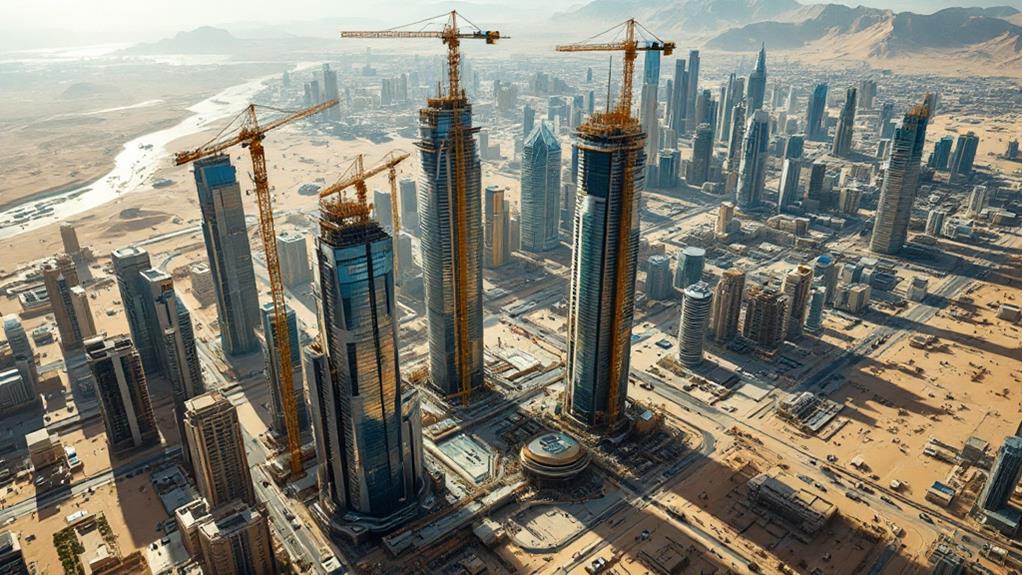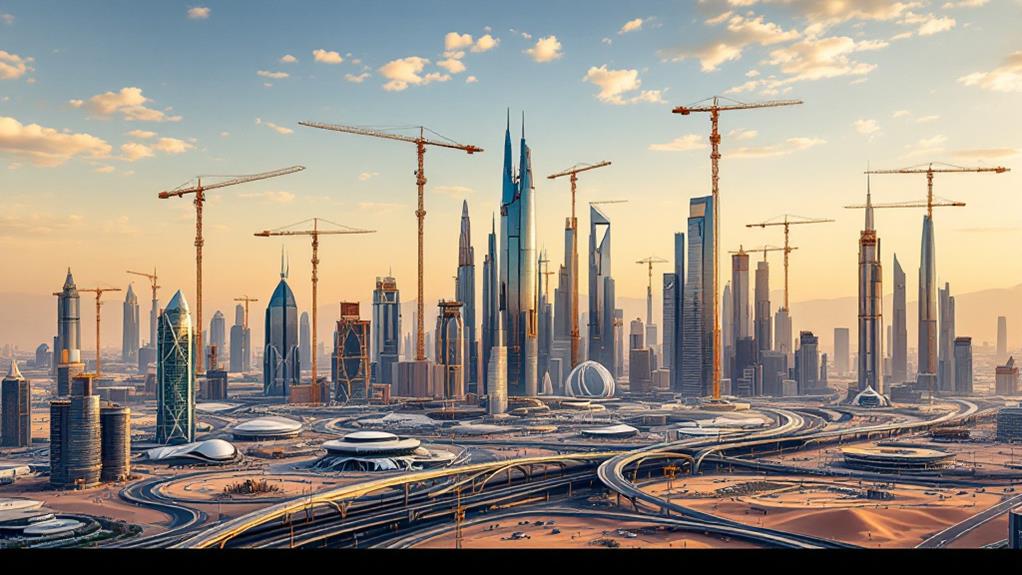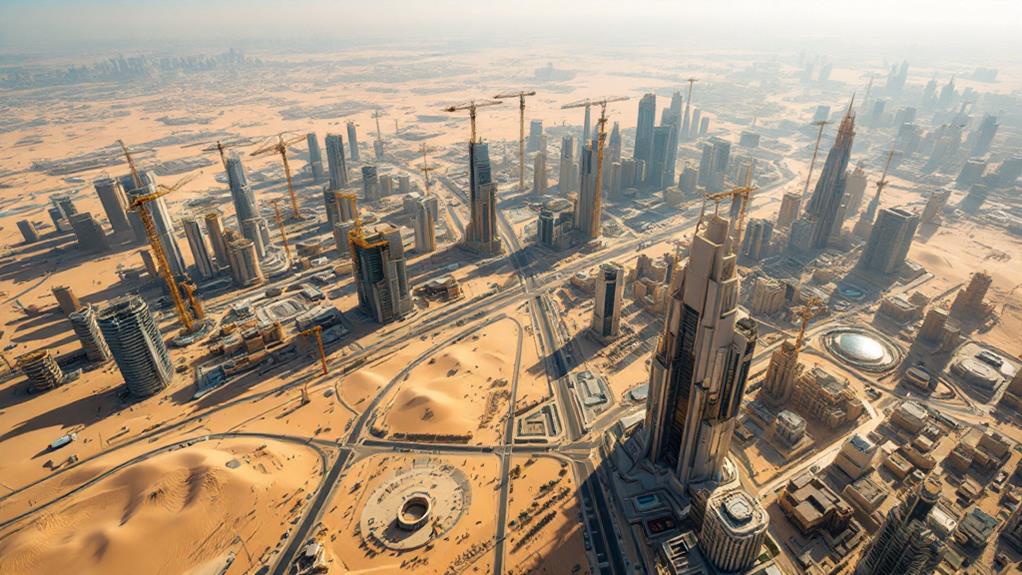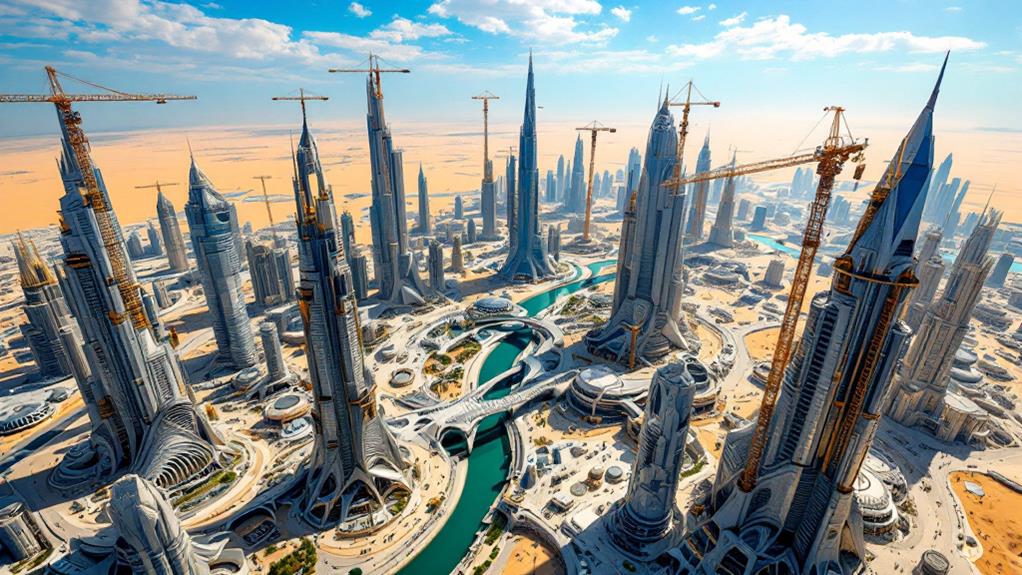The Largest Building Projects in the Middle East: A Construction Boom

You're entering a period of remarkable growth in the Middle East's construction sector, driven by massive investments and visionary projects. Saudi Arabia leads with its $1.3 trillion Vision 2030 initiative, featuring Neom, a futuristic city without cars or emissions. The U.A.E. is expanding its infrastructure, including the world's largest airport, while Egypt's strategic location bolsters its construction boom. Kuwait's groundbreaking $12 billion airport project and Bahrain's major transportation advancements reflect regional ambition. Meanwhile, sustainability and digital tools are transforming these projects, making the Middle East a hub of modern construction. Investigate further to uncover the scale and impact of this boom.
Saudi Arabia's Visionary Projects
Saudi Arabia's visionary projects are reshaping the country's future under the ambitious Vision 2030 plan. You're witnessing a bold transformation aimed at varying the economy away from oil. With a staggering $1.3 trillion invested in construction projects and infrastructure over the past eight years, the nation is setting a new course. Among these, the Neom megaproject stands out, with its massive $500 billion budget. Although Neom is a key highlight, let's not overlook the similarly significant Red Sea Project, which also contributes to this transformative wave.
These projects aren't just about building; they're about creating a sustainable future. For instance, Riyadh is investing $35 billion in new stadiums and hospitality, aiming to attract 150 million tourists each year by 2030. This aligns perfectly with Vision 2030's goals. As a result, the construction sector is on track for nearly 30% growth by 2028, with total output expected to hit $181.5 billion. The Public Investment Fund, boasting $700 billion in assets, demonstrates Saudi Arabia's commitment to these ambitious endeavors. You're seeing a nation not just constructing structures, but crafting a new identity for itself.
Neom: The Futuristic City
With a bold vision, Neom emerges as a groundbreaking megaproject set to redefine urban living in Saudi Arabia. Crown Prince Mohammed bin Salman spearheads this ambitious $500 billion initiative, positioning Neom as a keystone in the Kingdom's Economic Diversification strategy. Designed to accommodate around 9 million residents, Neom spans a colossal 10,230 square miles. It aims to become a guiding light of sustainability and innovation, integrating advanced technologies in its urban planning.
At the heart of Neom lies The Line, anticipated to be the world's largest construction site. This linear city stretches 105 miles and embodies a revolutionary approach to urban living—no cars, no emissions. It's a bold departure from traditional city layouts, prioritizing eco-friendly and sustainable living. Funded by Saudi Arabia's Public Investment Fund, which boasts over $700 billion in assets, Neom's budget accounts for more than half of the fund's resources.
Currently, Neom employs about 2,800 staff members, rapidly advancing this vast construction project. Real estate consultancy groups are closely watching Neom, recognizing its potential to set new standards for future cities. As a hub for innovation, Neom is poised to transform urban environments globally.
Riyadh's Infrastructure Expansion

As Riyadh commences on a transformative voyage, the city's infrastructure expansion takes center stage. With a keen focus on Saudi Arabia's Vision 2030, you're witnessing a city on the brink of a construction renaissance. The revelation of the 2034 FIFA World Cup stadium design, suspended 1,150 feet above the ground, is a demonstration of the boldness of these infrastructure projects. But that's just the beginning.
Here's what's set to unfold:
- Eight New Stadiums: Among them, the King Salman International Stadium will boast a capacity of 92,000 seats, making it a key venue for global events.
- Massive Investment: There's $35 billion in contracts available for numerous infrastructure projects, underscoring the significant financial commitment to Riyadh's growth.
- Accommodation Surge: You can expect 29,000 new hotel rooms and 340,000 homes, catering to the anticipated influx of tourists and residents.
- Tourism Goals: As part of Vision 2030, the city aims to draw 150 million tourists annually by the decade's end, solidifying Riyadh's status as a global destination.
These projects not only transform Riyadh but place it at the forefront of Saudi Arabia's ambitious future.
U.A.E.'s Innovative Developments
Innovation is at the heart of the U.A.E.'s remarkable developments, with billions poured into its construction sector to shape a future-ready nation. The U.A.E. has made substantial investments, with construction awards soaring to $31.6 billion in 2018 from $28.6 billion in 2017. This surge supports major projects, underscoring its commitment to becoming a global leader in creativity and development.
In Dubai, strategic infrastructure projects are crucial, particularly with the transformation brought by Expo 2020. This event serves as a showcase for the region's groundbreaking developments. Major projects like the Maktoum Airport Expansion, set to become the world's largest airport, highlight the U.A.E.'s vision. Moreover, the $13.61 billion Etihad Rail network connects key cities, enhancing national connectivity.
The U.A.E.'s focus on tourism is evident in its large-scale leisure projects. By improving its tourism sector, the country aims to secure its position as a global tourist destination. The construction industry is rapidly evolving, integrating digital tools and sustainable practices to enhance efficiency and meet global environmental standards. As you investigate the U.A.E's landscape, you'll witness a nation setting new benchmarks in construction and creativity.
Egypt's Strategic Growth

Turning attention from the U.A.E.'s groundbreaking landscape, Egypt's construction sector stands out with its impressive growth trajectory. You're witnessing a flourishing construction market with a project pipeline valued at approximately $490 billion. This surge is fueled by a demographic boom and a growing demand for utilities and residential infrastructure. As Egypt adopts modernity, key infrastructure projects are reshaping the nation.
The government's focus on infrastructure projects is evident through massive investments in roads, bridges, and housing. These efforts are part of a broader vision to foster sustainable urban development and improve connectivity. By prioritizing the expansion of transportation networks, Egypt is effectively linking new urban communities, stimulating economic activity, and enhancing accessibility.
Here are four key initiatives shaping Egypt's strategic growth:
- Urban Communities Development: New cities are being developed to accommodate the burgeoning population.
- Transportation Networks Expansion: Improved connectivity through new roads and bridges.
- Energy and Water Projects: Initiatives aimed at generating energy and managing water resources sustainably.
- Attracting Foreign Investment: Egypt's strategic location as a regional trade hub draws significant foreign investment, elevating the construction market.
These endeavors not only address critical needs but also position Egypt as a crucial player in the regional construction landscape.
Kuwait's Infrastructure Investments
Kuwait's commitment to bolstering its infrastructure is unmistakable. You can see this in the ambitious $12 billion airport project, which showcases the country's readiness for innovation and expansion. With contracts worth $3.7 billion awarded in just the initial half of 2018, Kuwait's construction projects are an indication of a sector that's actively pursuing growth. This drive is part of a broader initiative aimed at enhancing transportation and connectivity across the nation.
Public-private partnerships (PPP) are at the heart of Kuwait's strategy. By prioritizing these collaborations, the government optimizes infrastructure investment, enabling large-scale projects to come to fruition. The focus isn't just on transportation; it's also about meeting the needs of a growing population. Significant investments are being made in utilities and residential projects, guaranteeing that the infrastructure keeps pace with demographic changes.
Kuwait's approach exemplifies how strategic infrastructure investment can fuel national growth. By leveraging PPPs, Kuwait not only amplifies resources but also fosters innovation and sustainability within its construction projects. This proactive stance guarantees that as Kuwait grows, its infrastructure evolves to meet new challenges and opportunities, securing a prosperous future.
Oman and Bahrain's Ambitious Plans

As you investigate the ambitious plans of Oman and Bahrain, it becomes clear that both nations are committed to transforming their infrastructure landscapes. They're not just building for today but are laying the foundation for a diversified economic future.
Oman is making headway with a project pipeline valued at approximately $118 billion. This is part of their strategy for economic diversification, focusing heavily on construction projects that include significant investments in housing and utilities. Their approach involves special economic zones aimed at spurring growth in the construction sector and attracting foreign investment.
Bahrain, on the other hand, is zeroing in on enhancing its transport infrastructure. One standout initiative is the $18 billion airport expansion, designed to increase passenger capacity and improve connectivity. Bahrain's construction projects also prioritize housing projects to meet the rising demand for residential units, thereby contributing to urban development.
Both Oman and Bahrain are leveraging public-private partnerships (PPP) to optimize resources and mitigate risks in these ambitious undertakings. Here's a quick snapshot:
- Oman's $118 billion project pipeline.
- Special economic zones in Oman.
- Bahrain's $18 billion airport expansion.
- Focus on housing projects in Bahrain.
These plans are reshaping their economic futures.
Sustainability and Digital Advancements
Saudi Arabia's construction landscape is undergoing a transformative shift, emphasizing sustainability and digital advancements. With a massive $1.3 trillion investment over the past eight years, the focus is on integrating renewable energy and green materials into mega-projects like Neom and The Red Sea Project. These projects aren't just about grandeur; they're setting a benchmark for eco-friendly designs and practices. The Red Sea Project, for instance, aims to match environmental standards of Marine Protected Areas, considerably reducing carbon emissions and waste.
Digital transformation is at the heart of this revolution, reshaping how construction unfolds. You'll notice how AI, IoT, and blockchain are not just buzzwords but crucial tools enhancing project management. These technologies guarantee efficient resource use and secure transactions, streamlining processes like never before. By adopting digital tools and data analytics, you're also witnessing cost reductions and improved maintenance practices. This not only amplifies efficiency but drives sustainability across large-scale developments. As Saudi Arabia diversifies away from oil dependency, construction technology and digital transformation are critical, guaranteeing new projects align with sustainable development goals while paving the way for a greener, smarter future.



